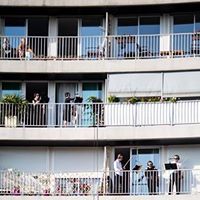Workshop: Introduction into LAMENTING with Tuomas Rounakari
Schedule
Sun Mar 23 2025 at 10:00 am to 02:00 pm
UTC+01:00Location
Teaterøen | Copenhagen , SK

Advertisement
Musician Tuomas Rounakari and choreographer Antoinette Helbing invite you to this workshop as a practice sharing event in connection with Helbing’s performance 'On/Crying - the Gravity of Tears which will' premiere at Metropolis 2025.NOTE: The workshop is free, but a registration at [email protected] is required.
About the Workshop
We will discuss the history and meaning of laments as a global tradition. Laments are musical expressions of grief that often include poetry. They have been described as an art for rites of passage, easing individuals and communities to meet the inevitable changes in life and death. How and why was lament-singing used for releasing emotional distress in the past, and how can we learn it today? The workshop includes practical exercises to bring forth a hands-on experience on how laments can be done. The course is open to everyone, and no previous experience is needed.
About Tuomas Rounakari
Tuomas Rounakari is an internationally acclaimed violinist, composer, ethnomusicologist and educator from Finland. His Doctorate of Arts thesis discusses the altered states of consciousness and the ability to engage in dialogue with the more-than-human through music.
Rounakari has been a key figure in the revival of the near extinct lament tradition in Finland. He learned the essence of laments from the Karelian elder Martta Kuikka, who was the first to bridge Karelian lament tradition and modern-day Finland. Subsequently, together with Pirkko Fihlman, Tuomas Rounakari developed a model of teaching laments in grief circles that allowed the participants to create their unique laments and be witnessed in their grief. During the past 20 years of workshops and ceremonies, Tuomas has been birthing and witnessing over a thousand individual laments across continents.
What is Lament?
Laments are a global genre of traditional music. They are a musical expression carried by emotion and they often combine melody, poetry and natural tears. Crying is not forced, but laments are made out of topics with a strong emotional need. They are made out of anything that we know will make us cry.
The earliest signs of laments are found from the Egyptian hieroglyphs that have a specific sign for a lamenter. Laments are still a living tradition despite centuries of suppression. They are found intact in islands of Greece, eastern parts of Romania, Karelia, Middle East and among indigenous cultures from Amazon and Africa to Papua New Guinea. Presently, we live in a time of revival of these traditions in Finland, Karelia and Ireland while in some parts of the world the suppression continues.
Laments were tied to rites of passage – traditionally to death and marriage. In both these events a community faces a loss of a member and thus there are two rites of passages at the same time. For the one who transcends and for the community that needs to deal with the immediate changes. Specific ritual laments took place in order to have a secure and healthy transition. But laments were also used outside of communal ceremonies. All of us live through a series of personal rites of passages. Laments have been used to assist in those as well; recovering from trauma, releasing emotional burdens, gaining new perspectives to difficult situations.
Advertisement
Where is it happening?
Teaterøen, William Wains Gade 11, 1432 København K, Danmark,Copenhagen, Copenhagen , DenmarkEvent Location & Nearby Stays:














![Honne [support: Liang Lawrence] \/\/ Pumpehuset - F\u00c5 BILLETTER](https://cdn.happeningnext.com/events6/banners/d4736ddae6c175b4d56e6be6f8285d732790091da9b1757c65c0661dce463638-rimg-w1200-h628-dcfaacfd-gmir?v=1739482188)





![Antigone [on strike]](https://cdn.happeningnext.com/events10/banners/9723816c087d7abea2342c02dca4f95cc7ba00b2a4f88e060e88571a8c2781fd-rimg-w1200-h675-dcd8bd8f-gmir?v=1739997243)